

Exploring our past to sort out myth from reality
Share this Page on
Facebook or Twitter

These are the voyages of the TimeShip Anachron.
Our Mission: To boldly explore the past, dispelling
mythinformation and mythconceptions
of American History along the way.
 Visit us on Facebook
Visit us on Facebook
Meet MythAmerica Series

Pt 1 Pt 2 Pt 3 Pt 4 Pt 5 Pt 6 Pt 7 Pt 8 Pt 9 Pt 10 Pt 11
The Not-So-Gay Nineties, Part 5
A Columbian Legacy
I have always found pictures like the following very unnerving. Maybe you do too.
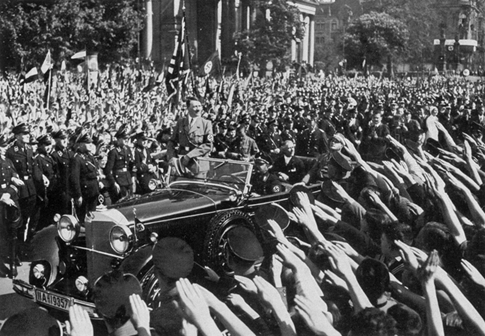
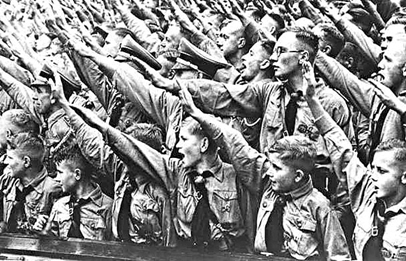
They are particularly unnerving when they show children!
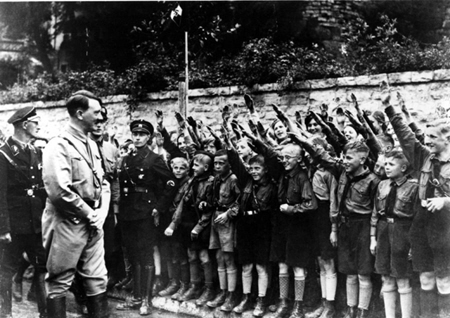
It seems so out of place for the innocence of youth to be swept along, indoctrinated if you will, with little understanding, into imitating the rigid rituals used in the whipping up of adult fervor, as in this pic from a Berlin school in 1934.
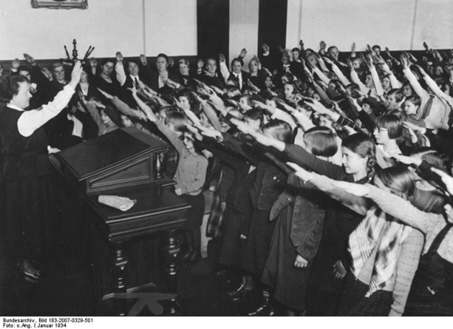
Yes, when I first saw the following two pics from 1942, they made my tummy sink a little.
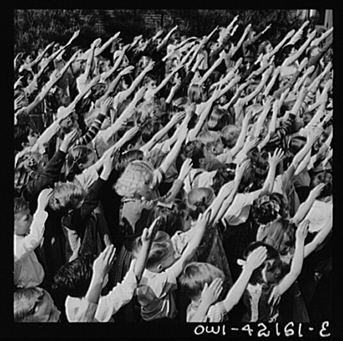
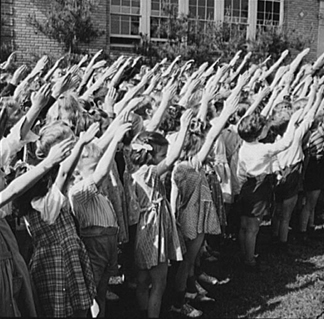
But you may wonder what this has to do with the Columbian Exposition and the Gay 90s in the US, since that is the theme of this blog series.
Well, see, those last two pics, from 1942, aren’t from Europe. And they aren’t of crowds of Hitler Youth and cheering Germans shouting Seig Heil (hail victory) to Der Fuehrer.
They are photos taken in schoolyards in the United States, pictures of American children in the good ol' USofA.
And therein lies a story you may not have heard, about one of the most influential legacies of the Columbian Exposition.
A few years back, when I first started my fascination with American World’s Fairs, and was reading about the Columbian Exposition of 1893, I ran across in my reading the name of a Victorian sci-
Looking Backward: 2000-
It was the third-
The premise of the book is sort of like the Rip Van Winkle story. Bostonian Julian West falls asleep in 1887 and wakes up in the year 2000. He finds that during his nap, the US has been transformed into a “socialist utopia.” And basically the rest of the book just follows him around as he explores this new environment—which is a manifestation of author Bellamy’s aspirations for how things “ought to be.” West’s “host,” Doctor Leete, explains the underlying theories of how and why the society works. This includes…
…drastically reduced working hours for people performing menial jobs and almost instantaneous, Internet-
Dr. Leete describes the “credit card” (yes, that is the word Bellamy came up with in 1887) issued to every member of American society in 2000:
"A credit corresponding to his share of the annual product of the nation is given to every citizen on the public books at the beginning of each year, and a credit card issued him with which he procures at the public storehouses, found in every community, whatever he desires whenever he desires it. This arrangement, you will see, totally obviates the necessity for business transactions of any sort between individuals and consumers. Perhaps you would like to see what our credit cards are like.
"You observe," he pursued as I was curiously examining the piece of pasteboard he gave me, "that this card is issued for a certain number of dollars. We have kept the old word, but not the substance. The term, as we use it, answers to no real thing, but merely serves as an algebraical symbol for comparing the values of products with one another. For this purpose they are all priced in dollars and cents, just as in your day. The value of what I procure on this card is checked off by the clerk, who pricks out of these tiers of squares the price of what I order."
Oh…yes. We’re familiar with this in 2013! It’s not really a “credit” card … it’s a Debit Card.
Edward Bellamy was what is often referred to as a “Christian Socialist.”
But our story for this blog entry isn’t about him. It is about his cousin, Francis Bellamy. Who was also a Christian Socialist. They worked together on many socialist projects.
[Francis] Bellamy was a Christian Socialist who "championed 'the rights of working people and the equal distribution of economic resources, which he believed was inherent in the teachings of Jesus.'” In 1891, Bellamy was forced from his Boston pulpit for his socialist sermons [he evidently openly described Jesus as a socialist…], and eventually stopped attending church altogether after moving to Florida, reportedly because of the racism he witnessed there. [Wiki]
In 1892, Francis Bellamy was working for a popular magazine aimed at youths and families, titled The Youth’s Companion. This magazine was one of the largest-
Both Daniel Ford and James Upham were leaders in the use of premiums. The Companion was the first magazine to use effectively the device of giving premiums for annual subscriptions, a practice it began under Daniel Ford's leadership in the late 1860's.
This premium system probably reached its highest development under his nephew, James Upham, who used the American flag as one of many premiums in promotion campaigns. Premiums were given to new subscribers, old subscribers for renewals, and to subscribing clubs and institutions like schools and churches.
By the time of Upham, subscribers could buy many items from the Premium Department. For over a half century, The Companion issued, in late October, a "Premium List Number" containing pictures and descriptions of many different types of goods. This premium number was in many ways the predecessor of the mail order catalogue of Sears and Roebuck. The premiums included laying hens, microscopes, singing canaries, steam engines, 93-
Around 1888, Upham came up with the idea to encourage schools across the land to display the US flag, either on an upright flagpole in the school yard or on a flag staff projecting from the building. Conveniently, the Companion’s premium department was prepared to sell flags of all kinds and sizes…including the perfect size to display for such a purpose.
By 1888 he had launched his School Flag Movement not only to sell flags but also to raise the level of patriotism in the schools. His promotion often would take the form of an advertisement in the magazine.
One very successful ad urged the student to write the Companion for one hundred cards bearing the inscription: " This Certificate entitles the holder thereof to one share in the patriotic influence of a Flag over the schoolhouse." These cards, sold by the pupil at ten cents each, brought in the ten dollars to buy a flag sold from the Premium Department. The Board of Education was asked to furnish the flag staff. This plan, supported by spirited literature, resulted in about twenty-
Up until this point, the only institutions that regularly flew the Flag daily were military installations. Moving beyond the use of magazine ads to promote the school flag idea, Upham solicited the endorsement of the National Education Association and the US Government.
What in Upham’s background fed his enthusiasm for this project? It seems to be commonly attributed to the fact that he was a dedicated member of the Masons.
Upham was a Knight Templar in the Masonic "Converse Lodge" in Malden (the Converses were a wealthy local family). The Order of Knights Templar, also know as the American Rite, is the highest order in the York Rite, the largest Masonic organization in the United States. This is the equivalent in prestige to a Thirty-
…To exaggerate only slightly, many of the Masons believed that the United States of America, itself, was the Mason's greatest creation. Many of the founding fathers were Masons, including "Brothers" George Washington, Benjamin Franklin, Alexander Hamilton, and James Monroe. The great Supreme Court Justice, John Marshall, was also a Mason.
By the turn of the century, almost half of the American Presidents had been Masons, including Garfield, Cleveland, McKinley, Roosevelt, and Taft. The three-
Masons believed that there is an essential link between freedom and education and that this linkage requires support for a free, non-
So Upham was gung-
Plans had long been underway for the Columbian Exposition to start in 1892. But as 1891 progressed it became obvious that the grandiose building plans were going to take longer to complete. Still, work was progressed far enough by October 1892 for an official initial “opening ceremony” connected with a ground-
And that’s where Francis Bellamy enters the picture. Upham and the people helping him plan the ceremony, that was to be printed in the magazine and distributed nationwide to schools, envisioned a ceremony that would everywhere feature a flag-
Francis Bellamy, Christian socialist, was the author of that pledge. In its original form, used at the nationwide ceremony that year centered on the Columbian Exposition, it read:
I pledge allegiance to my Flag and the Republic for which it stands,
one nation indivisible, with liberty and justice for all.
(Many folks these days seem unaware that the words "under God" were not in the original pledge. They were not added until the 1950s-
While composing the wording for the pledge, Bellamy had considered including the slogan of the French Revolution, (in English) “liberty, equality, fraternity.” But his biographers note that he realized that many among the southern contingent of educators…superintendents and such…who were supporting the program, might be offended and probably balk at the use of the words “equality” and “fraternity” as applying to African-
I must admit I find it somewhat ironic that most folks don’t realize that the author of the Pledge was envisioning a Socialist Republic when he penned the words that they now recite!
Upham himself came up with the idea that a ritual “gesture”—a salute to the flag—would be needed for use with the pledge. And he evidently choreographed that gesture. In the official program for the celebration, Bellamy provided the description below for this salute, which for many years was dubbed “The Bellamy Salute” since it was connected with the pledge written by Bellamy:
At a signal from the Principal the pupils, in ordered ranks, hands to the side, face the Flag. Another signal is given; every pupil gives the flag the military salute -
The campaign was a rousing success, and hundreds of thousands of children joined their voices in the Pledge for the first time on October 12, 1892, at exactly the same time as the ceremony proceeded at the grounds of the Columbian Exposition, with Bellamy and Upham there to view the fruit of their labors. And the ritual was so well-
And so here you have it, the salute to the flag in schools across the land, as seen, for instance, in this ceremony in 1915...
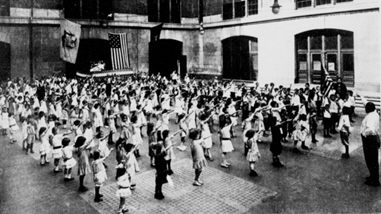
...or as practiced by this group in 1900...
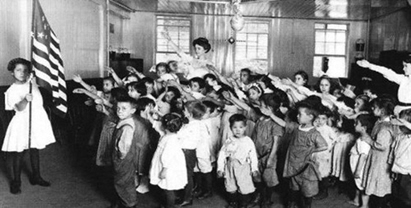
...or by this group of “negro” children at their own segregated school in 1900...


...or by the students in these two groups, from undated pictures.
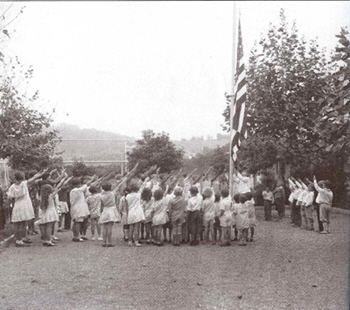
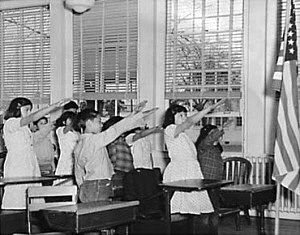
Those undated pics, like those earlier 1942 pictures I included at the beginning of this blog entry, would have to have been taken before December, 1942. Because by that point too many folks were noticing the painfully obvious similarity between the Nazi salute—seen in so many photos and newsreels in American theaters and newspapers-
There have long been groups in the US who were opposed to the pressure, particularly on children, to say the pledge, often because of religious scruples.
In 1940 the Supreme Court, in Minersville School District v. Gobitis, ruled that students in public schools, including the respondents in that case, Jehovah's Witnesses who considered the flag salute to be idolatry, could be compelled to swear the Pledge. A rash of mob violence and intimidation against Jehovah's Witnesses followed the ruling. [Wiki]
In other words, it wasn’t just legal sanctions that pressured these folks and led to violence against them…it was rabid “nationalistic” fervor of common citizens. How sad.
Walter Gobitas was a recent convert to the Jehovah's Witnesses. Gobitas was inspired by stories of other Jehovah's Witnesses who challenged the system and suffered for it, and decided to make a stand himself and instructed his children not to pledge allegiance when at school.
Minersville, Pennsylvania was predominantly Roman Catholic and there was significant animosity towards the Jehovah's Witnesses. Tensions were already high before this case arose and many viewed this as one way to get back at the troublesome Witnesses. As a result, his children were subjected to teasing, taunting, and attacks from the other kids.
For [Walter's daughter] Lillian, this meant giving up her status as class president and losing most of her friends. "When I'd come to school," she said, "they would throw a hail of pebbles and yell things like, 'Here comes Jehovah!' [Walter's son] Billy's fifth grade teacher attempted to physically force his arm out of his pocket to make the requisite salute.
A local Catholic church started a boycott of the family store and its business dropped off. Because of their eventual expulsion, their father had to pay for them to enroll in a private school, resulting in even more economic hardship.
At first the school board was in a quandary because the law did not provide penalties for those who refused to pledge. Finally, though, the school board got permission to punish the Gobitas children and expelled them, without appeal. [Wiki]
I personally find the conclusions of the Supreme Court (in an 8-
Frankfurter wrote that the school district's interest in creating national unity was enough to allow them to require students to salute the flag. According to Frankfurter, the nation needed loyalty and the unity of all the people. Since saluting the flag was a primary means of achieving this legitimate goal, an issue of national importance was at stake.
The Court held that the state's interest in "national cohesion" was "inferior to none in the hierarchy of legal values".
"National unity is the basis of national security. To deny the legislature the right to select appropriate means for its attainment presents a totally different order of problem from that of the propriety of subordinating the possible ugliness of littered streets to the free expression opinion through handbills."
Weighing the circumstances in this case, he argued that the social need for conformity with the requirement was greater than the individual liberty claims of the Jehovah's Witnesses. He emphasized that "Conscientious scruples have not, in the course of the long struggle for religious toleration, relieved the individual from obedience to a general law not aimed at the promotion or restriction of religious beliefs."
Frankfurter further wrote that the recitation of a pledge advanced the cause of patriotism in the United States. He said the country's foundation as a free society depends upon building sentimental ties.
The flag, the Court found, was an important symbol of national unity and could be a part of legislative initiatives designed "to promote in the minds of children who attend the common schools an attachment to the institutions of their country." The ruling was made on June 3, 1940. It’s repercussions across the land were almost immediate. [ibid]
The ruling set off a quick firestorm of persecution across the country. Sometimes literally.
On June 9, a mob of 2,500 burned the Kingdom Hall in Kennebunkport, Maine.
On June 16, Litchfield, Illinois police jailed all of that town's sixty Witnesses, ostensibly protecting them from their neighbors.
On June 18, townspeople in Rawlins, Wyoming brutally beat five Witnesses; on June 22, the people of Parco, Wyoming tarred and feathered another.
American Legion posts harassed Witnesses nationwide. For example, on June 27, members of the American Legion forced Witnesses from a trailer camp in Jackson, Mississippi and escorted them across state lines to Louisiana, where they were "...passed from county to county, finally winding up in the vicinity of Dallas, Texas."
A Nebraska Witness was castrated.
Little Rock Witnesses were beaten with pipes and screwdrivers.
West Virginia Witnesses were forced to drink castor oil and then tied together with police department rope.
Witnesses were jailed for sedition, jailed for distributing literature, jailed for holding a parade, jailed for canvassing without a license.
The American Civil Liberties Union reported to the Justice Department that nearly 1,500 Witnesses were physically attacked in more than 300 communities nationwide. One Southern sheriff told a reporter why Witnesses were being run out of town: "They're traitors; the Supreme Court says so. Ain't you heard?"
First Lady Eleanor Roosevelt appealed publicly for calm, while newspaper editorials and the American legal community condemned the Gobitis decision as a blow to liberty. [ibid]
Yes, to make sure that everyone pledged allegiance to a flag that was supposedly a symbol of a country and government dedicated to "liberty and justice," it was necessary to force them to perform this "civic ritual" under pain of taking away their liberty and justice-
Gratefully, common sense and reasoning eventually broke through, and the ruling was changed by the Supreme Court only three years later. But I’m suspicious that this did little to calm down the “popular” persecution of Jehovah’s Witnesses and others who refused to participate in the pledge ceremony.
In 1943 the Supreme Court reversed its decision, ruling in West Virginia State Board of Education v. Barnette that public school students are not required to say the Pledge, concluding that "compulsory unification of opinion" violates the First Amendment.
In spite of this ruling, clear back in 1943, “popular” sentiment against any religious objectors who have scruples against saying the pledge still remains in some quarters seventy years later. But at least you don’t hear of too many cases of physical violence against them these days.
So there you have it. One of the most enduring parts of the legacy of the 1893 World’s Fair is the civic ritual that has been repeated daily across the land in many schools and other institutions for over a century. (My husband mentioned to me that even the Toastmaster’s Club he belonged to a while back recited the Pledge at the beginning of every meeting).

But the Ferris Wheel and the Pledge are certainly not the only “leftovers” from the 1893 Fair.